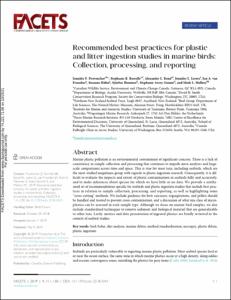| dc.contributor.author | Provencher, Jennifer F. | |
| dc.contributor.author | Borrelle, Stephanie B. | |
| dc.contributor.author | Bond, Alexander L. | |
| dc.contributor.author | Lavers, Jennifer L. | |
| dc.contributor.author | van Franeker, Jan A. | |
| dc.contributor.author | Kühn, Susanne | |
| dc.contributor.author | Hammer, Sjúrður | |
| dc.contributor.author | Avery-Gomm, Stephanie | |
| dc.contributor.author | Mallory, Mark L. | |
| dc.date.accessioned | 2021-10-25T12:04:49Z | |
| dc.date.available | 2021-10-25T12:04:49Z | |
| dc.date.issued | 2019 | |
| dc.identifier.citation | Provencher, J.F., Borrelle, S.B.,
Bond, A.L., Lavers, J.L., van Franeker, J.A., Kühn, S.,
Hammer, S., Avery-Gomm, S., and
Mallory, M.L. (2019) Recommended best
practices for plastic and litter ingestion
studies in marine birds: Collection,
processing, and reporting. FACETS 4:
pp.111–130. DOI:10.1139/facets-2018-0043 | en_US |
| dc.identifier.uri | https://repository.oceanbestpractices.org/handle/11329/1758 | |
| dc.description.abstract | Marine plastic pollution is an environmental contaminant of significant concern. There is a lack of
consistency in sample collection and processing that continues to impede meta-analyses and largescale
comparisons across time and space. This is true for most taxa, including seabirds, which are
the most studied megafauna group with regards to plastic ingestion research. Consequently, it is difficult
to evaluate the impacts and extent of plastic contamination in seabirds fully and accurately,
and to make inferences about species for which we have little or no data. We provide a synthesized
set of recommendations specific for seabirds and plastic ingestion studies that include best practices
in relation to sample collection, processing, and reporting, as well as highlighting some
“cross-cutting” methods. We include guidance for how carcasses, regurgitations, and pellets should
be handled and treated to prevent cross-contamination, and a discussion of what size class of microplastics
can be assessed in each sample type. Although we focus on marine bird samples, we also
include standardized techniques to remove sediment and biological material that are generalizable
to other taxa. Lastly, metrics and data presentation of ingested plastics are briefly reviewed in the
context of seabird studies. | en_US |
| dc.language.iso | en | en_US |
| dc.rights | Attribution 4.0 International | * |
| dc.rights.uri | http://creativecommons.org/licenses/by/4.0/ | * |
| dc.subject.other | Plastic pollution | en_US |
| dc.subject.other | Plastic debris | en_US |
| dc.subject.other | Marine plastics | en_US |
| dc.subject.other | Marine debris | en_US |
| dc.subject.other | Plastic ingestion | en_US |
| dc.subject.other | Birds | en_US |
| dc.subject.other | Bolus | en_US |
| dc.subject.other | Diet analysis | en_US |
| dc.subject.other | Necropsy | en_US |
| dc.title | Recommended best practices for plastic and litter ingestion studies in marine birds: Collection, processing, and reporting. | en_US |
| dc.type | Journal Contribution | en_US |
| dc.description.refereed | Refereed | en_US |
| dc.format.pagerange | pp.111-130 | en_US |
| dc.identifier.doi | 10.1139/facets-2018-0043 | |
| dc.subject.parameterDiscipline | Anthropogenic contamination | en_US |
| dc.bibliographicCitation.title | FACETS | en_US |
| dc.bibliographicCitation.volume | 4 | en_US |
| dc.description.sdg | 14.1 | en_US |
| dc.description.sdg | 14.a | en_US |
| dc.description.eov | Marine debris | en_US |
| dc.description.methodologyType | Method | en_US |
| dc.description.methodologyType | Specification of criteria | en_US |
| obps.contact.contactname | Jennifer Provencher | |
| obps.contact.contactemail | Jennifer.provencher@canada.ca | |
| obps.resourceurl.publisher | https://www.facetsjournal.com/doi/10.1139/facets-2018-0043 | |
 Repository of community practices in Ocean Research, Applications and Data/Information Management
Repository of community practices in Ocean Research, Applications and Data/Information Management

